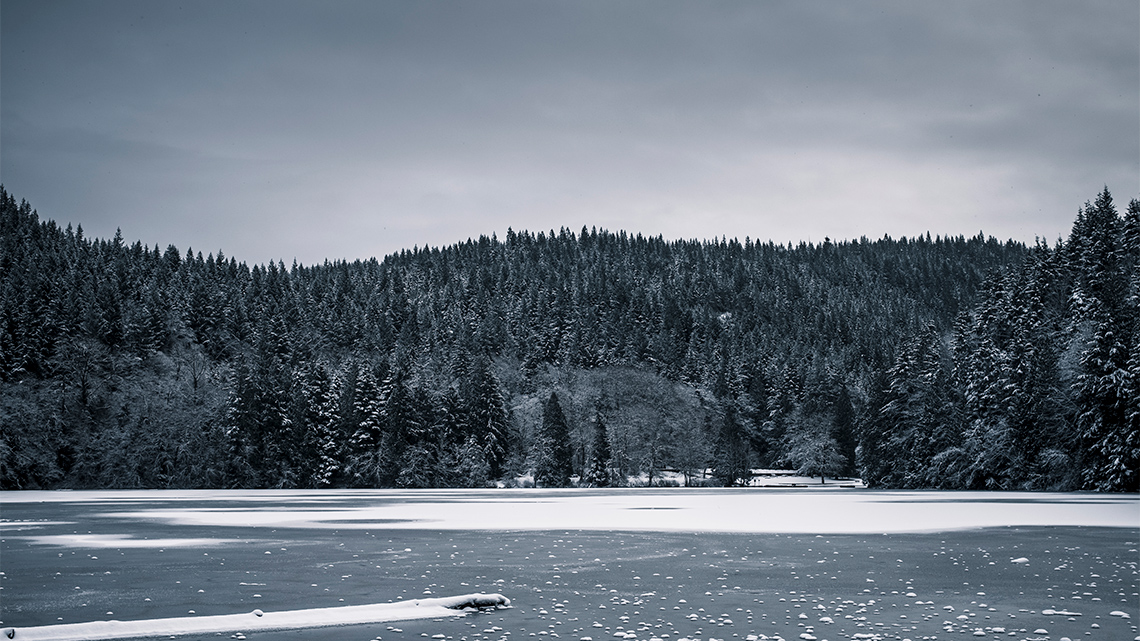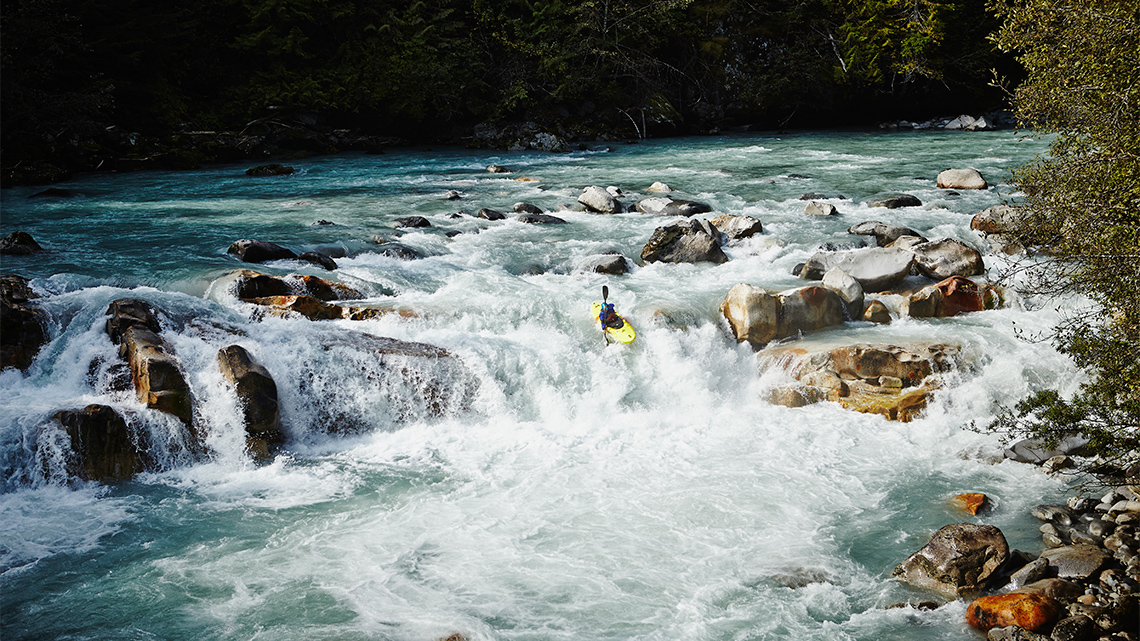Minds On
Warm up
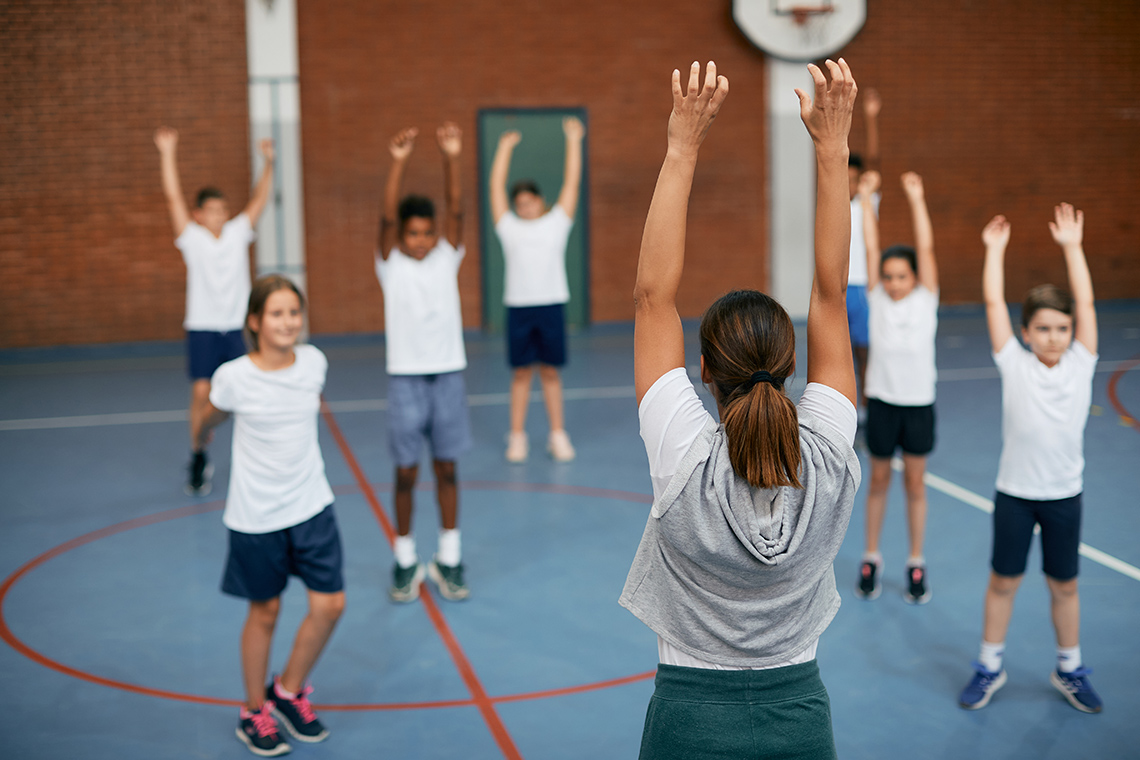
Don't forget to do your safety check!
Warm Up
Breathe in and out
For our warm-up activity, access this audio clip entitled “Breathing Activity” to learn more about taking deep breaths.
Breathing Activity
Find a comfortable position. Focus your attention on one part of the body at a time.
How does that part of your body feel? If possible, take a deep breath and allow your lungs to expand.
Now, focus your attention on one part of your body. Allow that part to relax before moving on to the next.
As you scan through your body, keep breathing deeply.
Once you have completed the scan, take a moment to stretch.
Drama game
Let’s check out the following images.
While exploring the images, think of five words to describe each image.
Record your words in a notebook or another method of your choice.
When you are finished, read out the words. How do they make you feel?
Let’s get started!
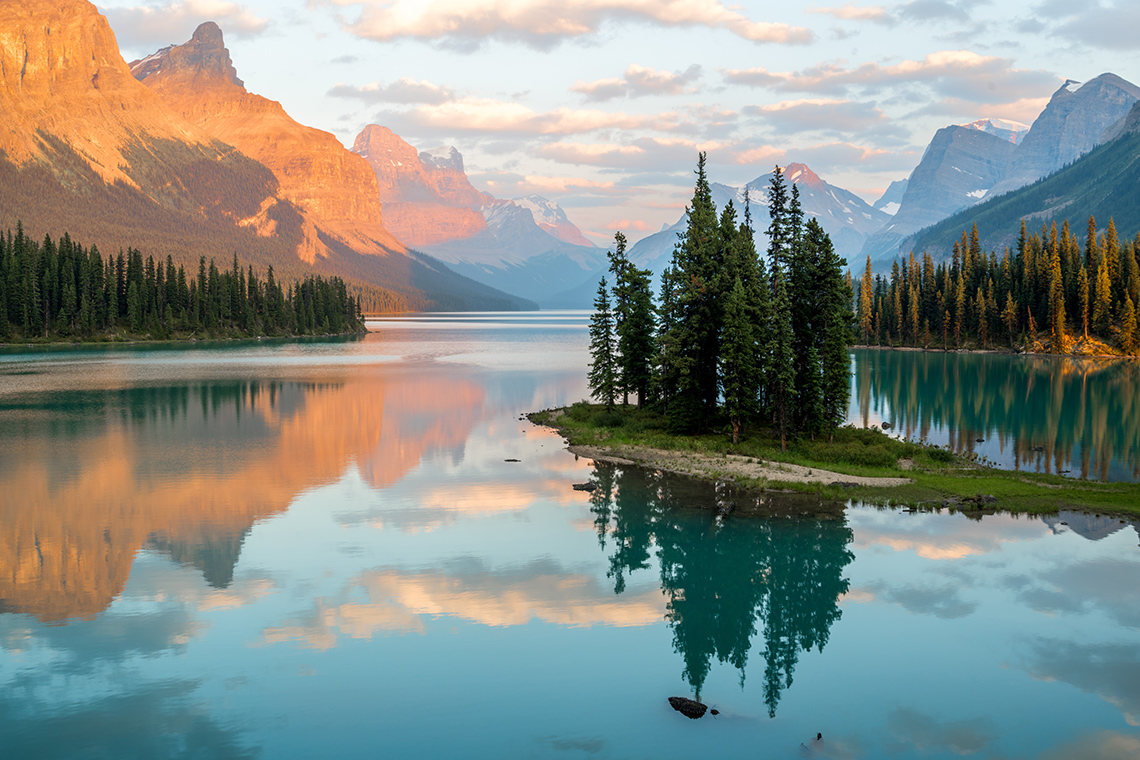
Connecting to water
Imagine a body of water. It could be a river, stream, waterfall, or the middle of the ocean.
What is the weather like by the body of water? Is the sky clear, is it windy?
How does the weather affect the body of water? Is the water still and smooth or are there big waves forming?
Is the water rushing fast, or moving slowly? What might the water sound like?
Represent the movement of water with your body, gestures, or sounds.
You can also create a description of how the water might move, sound, or feel.
Press ‘Let’s Check!’ to access various movements.
To represent water, we can move our hands like waves, like in the following video.
We can also make sounds of a waterfall, or use our body movements to show water moves.
Action
Time and place
While the content in this learning activity is aligned to the curriculum, some content may be sensitive to individual learners. Consider reaching out to a trusted adult to share your feelings and questions.
In the Minds On section, you practised connecting to the setting of water. In drama, the story can be created around the central characters. One of the elements of drama that can help the audience understand the story is time and place. The setting of the story and time it takes place, helps the audience understand where and when in history the drama happened.
Did You Know?
Did you know?
A drama can be based on real-life events, or it can be a fictional account.
The time and place in the drama can also be connected to a theme, or an important thing or idea that helps guide the audience through the story.
Shi-shi-etko
The author of Shi-shi-etko, Nicola I. Campbell, is Interior Salish (Nłeʔkepmx and Syilx) and Métis from the Nicola Valley, British Columbia.
In this area, there are many First Nations communities whose traditional name for their nation reflects their relationship with the lands and waters that surround them.
- For example, Nłeʔkepmx means people of the canyon.
- Gitxsan is for the people of the Skeena River.
- Sekani or Wem means people on the rocks or mountains.
- Nuu-chah-nulth means all along the mountains and sea.
- Pascheenaht is for the people of the sea foam.
Guided reading
Let's revisit the story, Shi-shi-etko. As you read the story this time, consider the following questions: How is time and place is represented in the story?
Is there an important place in the story that the author might be emphasizing?
What does this mean to the main character?
How might time and place be represented in a staged drama production of this story?
Record your responses using a method of your choice.
Hint: The name of the main character, Shi-shi-etko, means "she who loves to play in water".
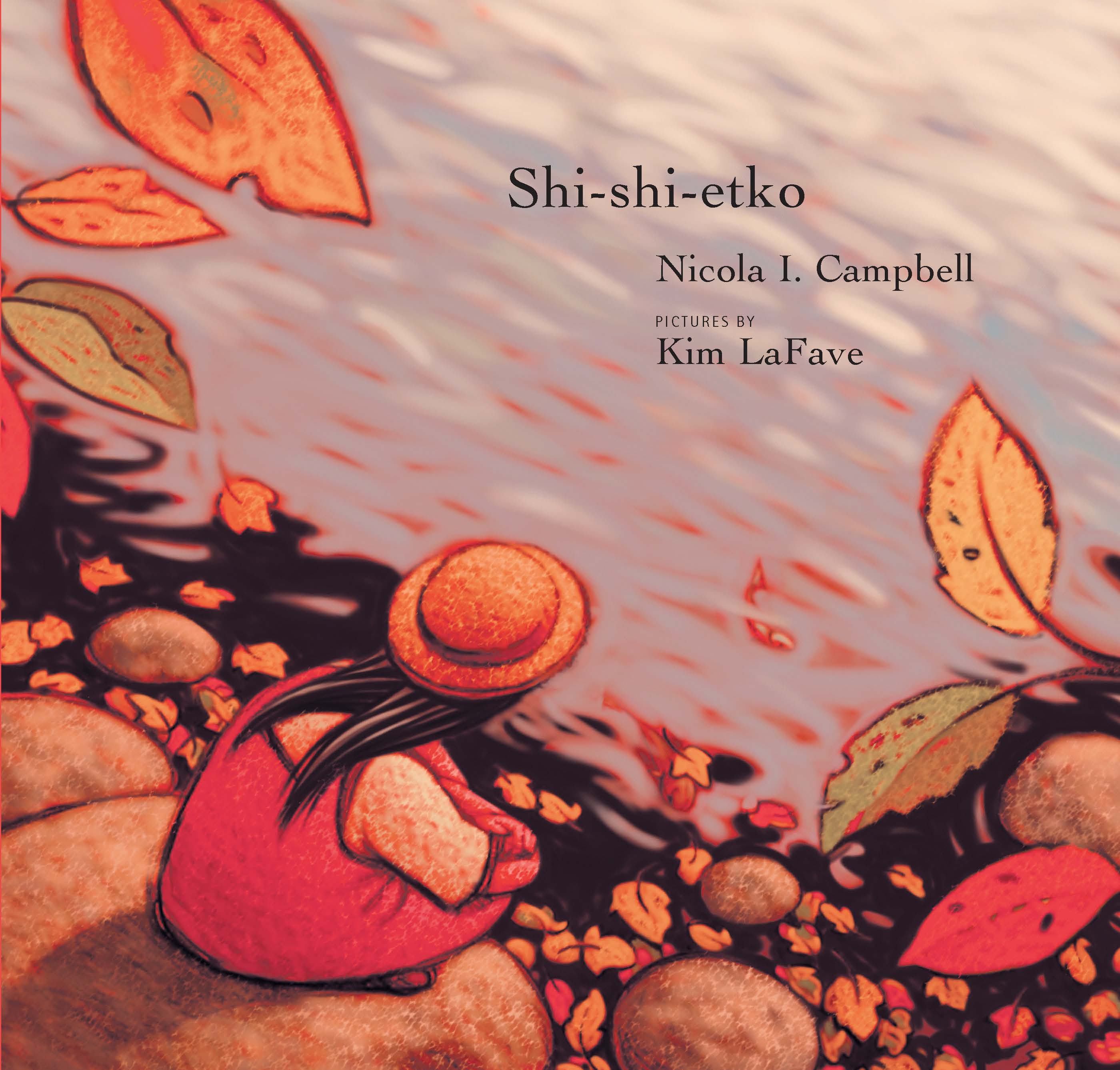
Shi-shi-etko by Nicola I. Campbell, and illustrations by Kim LaFave
This is the cover of an illustrated book, Shi-shi-etko, by Nicola I. Campbell, and illustrations by Kim LaFave. The cover shows a young girl sitting on a rock by a pond. There are coloured leaves falling around the child and floating in the pond.
Reading Time
Preface
Let’s explore the preface for the book, Shi-shi-etko.
“This story is about a little native girl named Shi-shi-etko, which means “she loves to play in the water.” Shi-Shi-etko’s people have always lived in North America, hunting, fishing, and gathering traditional foods and medicines, making their own clothing and building their own houses, making their own rules and taking care of their traditional territories, telling stories, singing, and dancing. Native children were loved so much that the whole community raised them together – parents, grandparents, aunties, uncles, cousins, and elders.
But now Shi-shi-etko has to go to Indian Residential School. It is the law. The school is far away from her home, and she will have to travel for a couple of days to get there. Once she arrives at the school, she won’t see her parents for many months or even years, she will lose her traditional name, and she will be forced to speak English – a language she doesn’t know.
For a long time, the Canadian government believed that native people were uncivilized and made laws forcing native children as young as four, although generally between the ages of five and six, to go to residential school to learn European culture and religion. Parents were put in jail if they didn’t send their children to these schools. Can you imagine a community without children? Can you imagine children without parents?
Residential schools had a huge impact on native people around the world, not only in Canada, but in the United States, Australia, and New Zealand, as well. They resulted in a devastating loss of native traditions, languages, and cultures. The last residential school in Canada closed in 1996.
The effects of the residential school system continue to hurt native people today. It is said that it will take seven generations for our people to heal.”
Let’s read!
Explore the following pages:
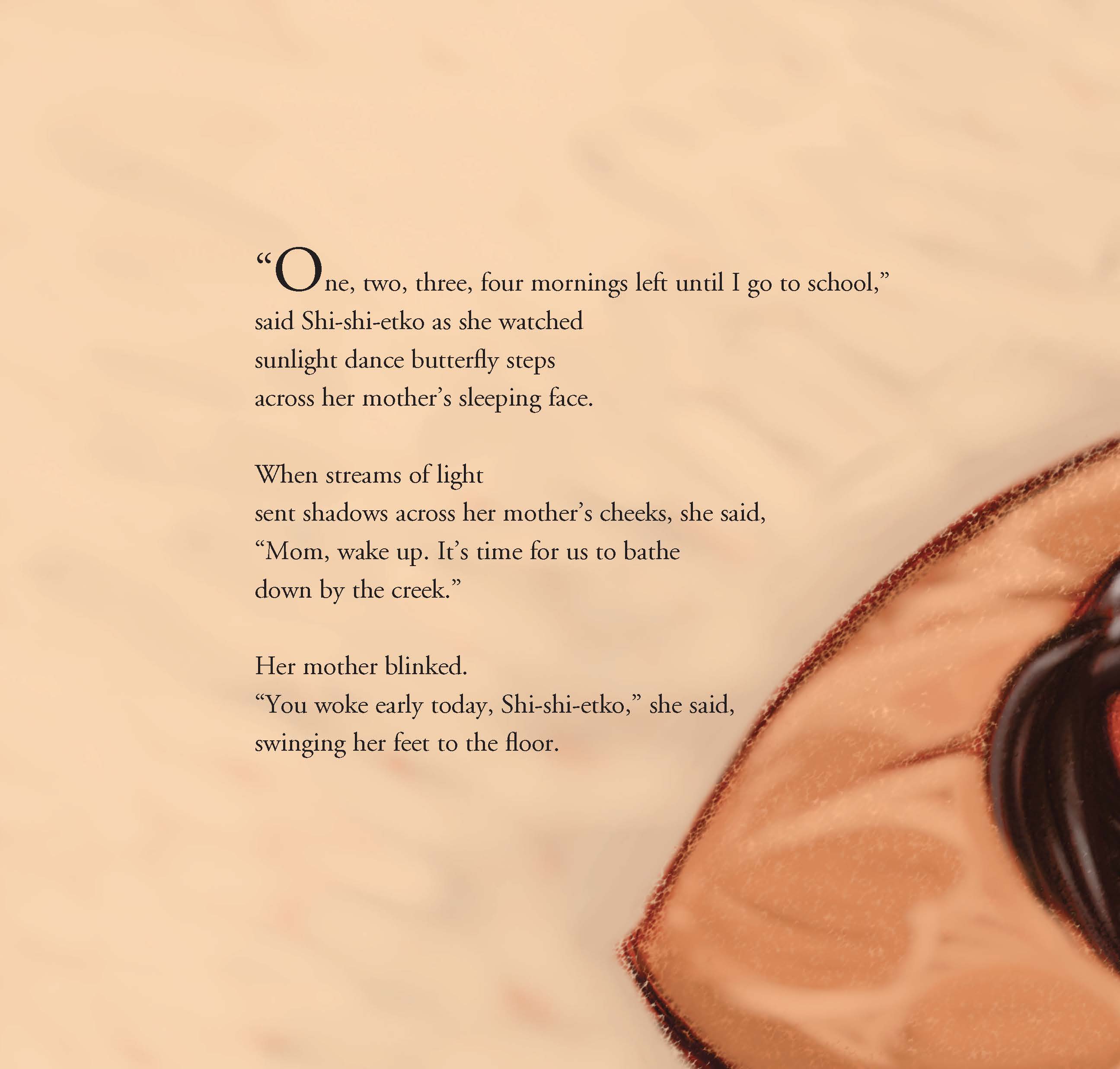
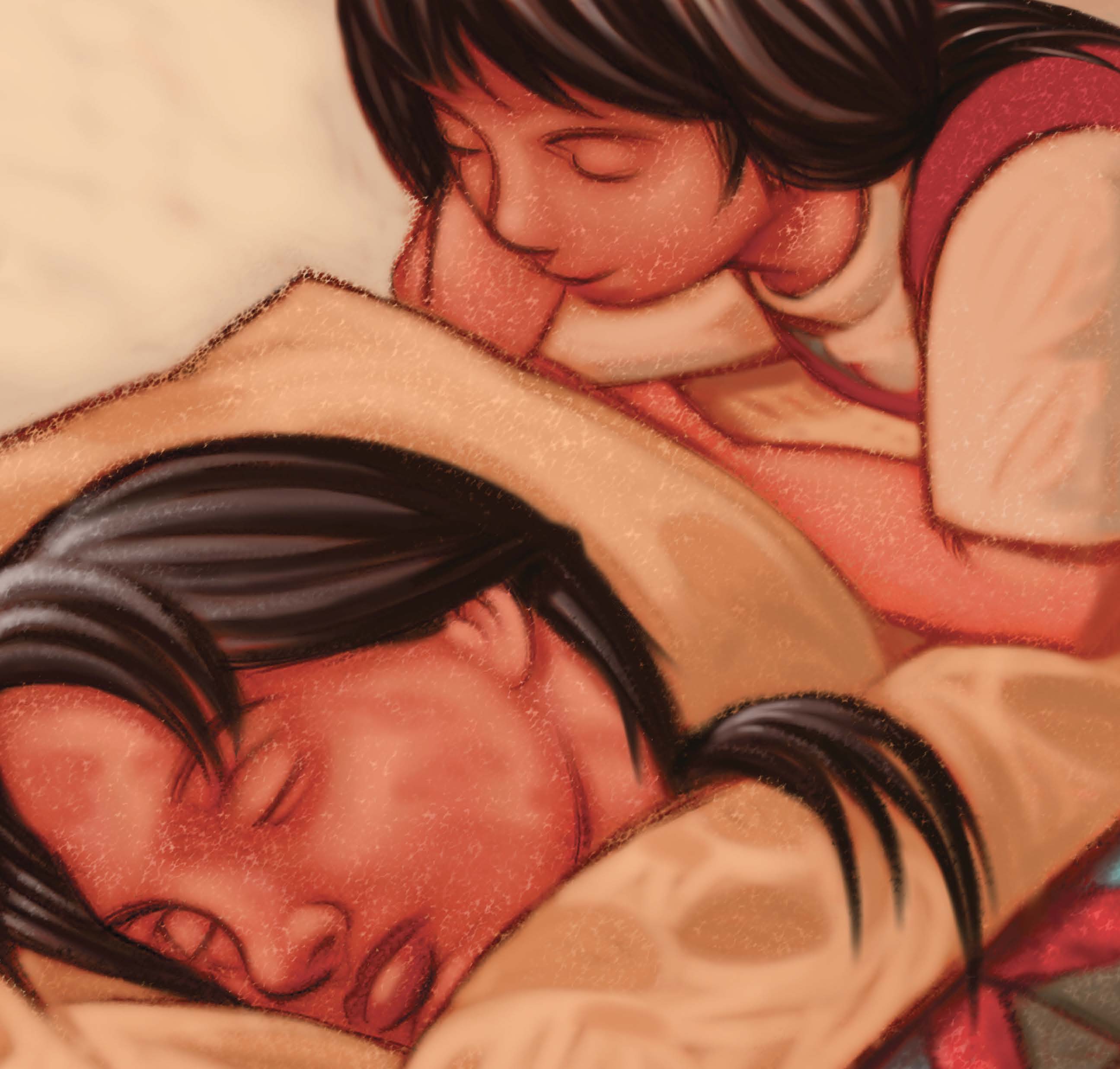
Page 1 & 2
“One, two, three, four mornings left until I go to school,” said Shi-shi-etko as she watched sunlight dance butterfly steps across her mother’s sleeping face.
When streams of light sent shadows across her mother’s cheeks, she said, “Mom, wake up. It’s time for us to bathe down by the creek.”
Her mother blinked. “You woke early today, Shi-shi-etko,” she said, swinging her feet to the floor.
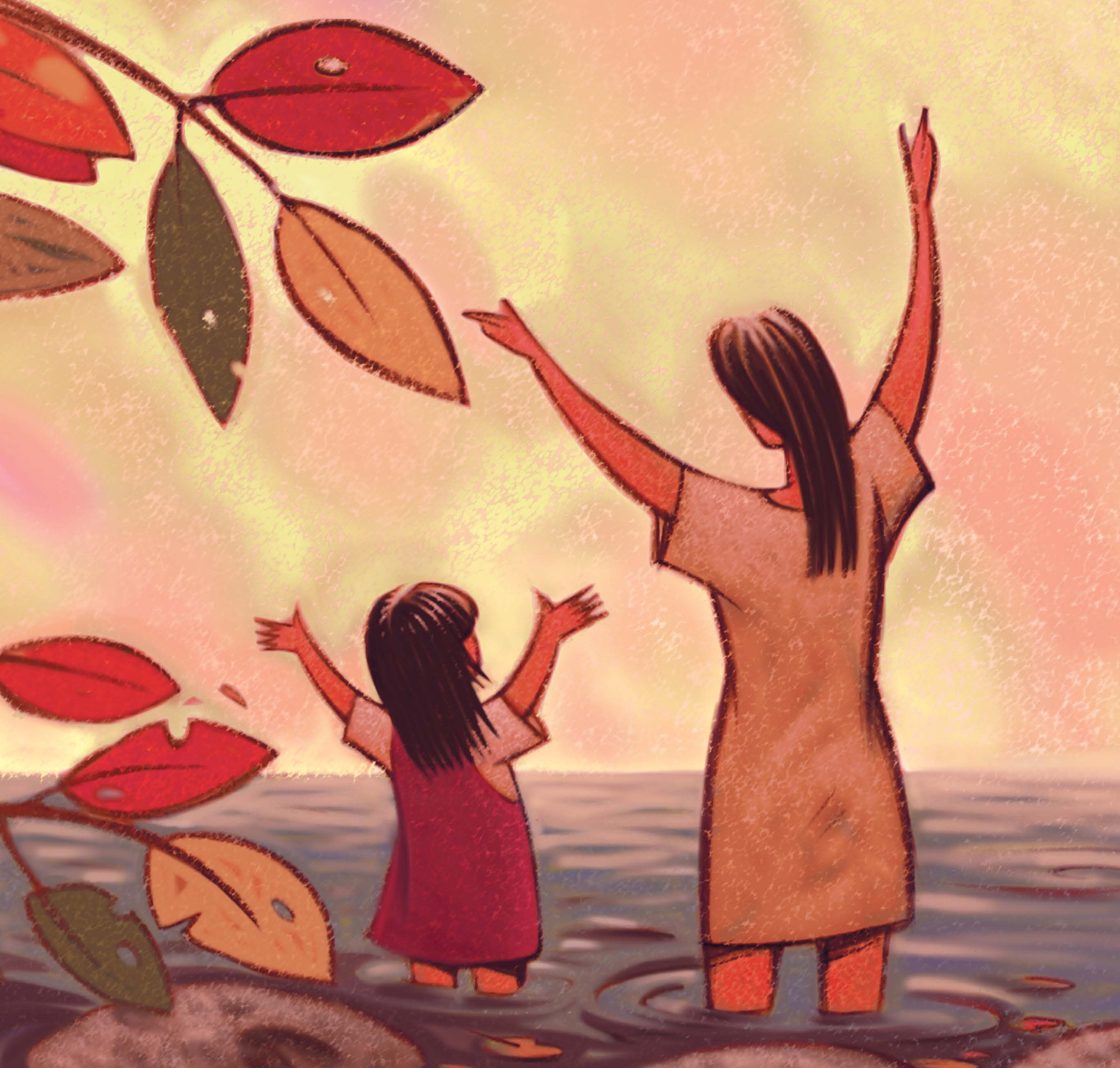

Page 3 & 4
With the first steps of sunrise Shi-shi-etko skipped along the worn path through the cottonwood trees all the way to the creek.
“My girl, we will not see each other until the wild roses bloom in the spring and the salmon have returned to our river. I want you to remember the ways of our people. I want you to remember our songs and our dances, our laughter and our joy, and I want you to remember our land.”
Then her mother began to sing. Her voice traveled from tree to tree, flowing through the valley, caught by the wind, carried on the wings of eagles in flight.
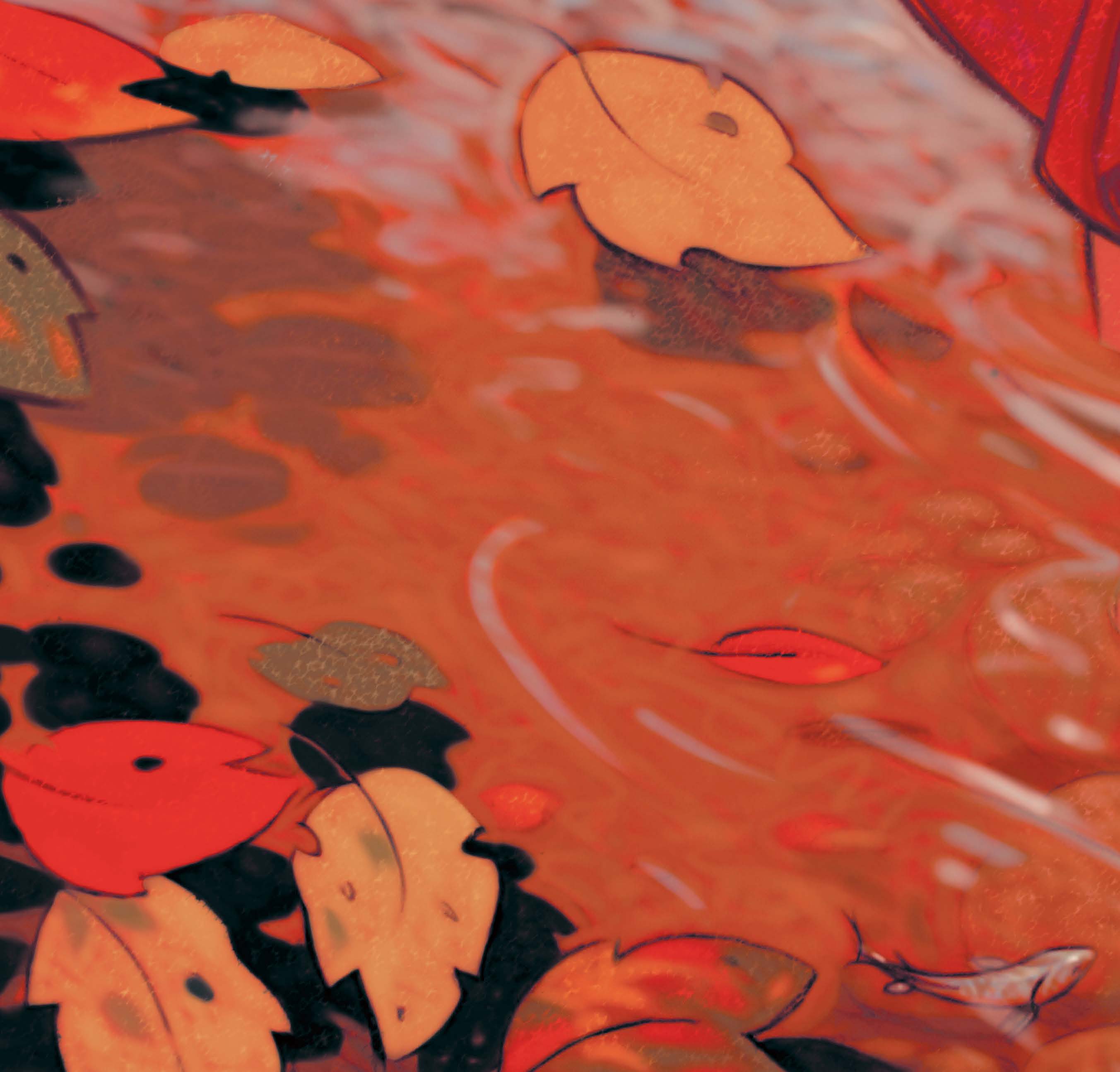

Page 5 & 6
Shi-shi-etko could not help herself. She looked at everything—tall grass swaying to the rhythm of the breeze, determined mosquitoes, working bumblebees. She memorized each shiny rock, the sand beneath her feet, crayfish and minnows and tadpoles that squirmed between her toes, all at the bottom of the creek.
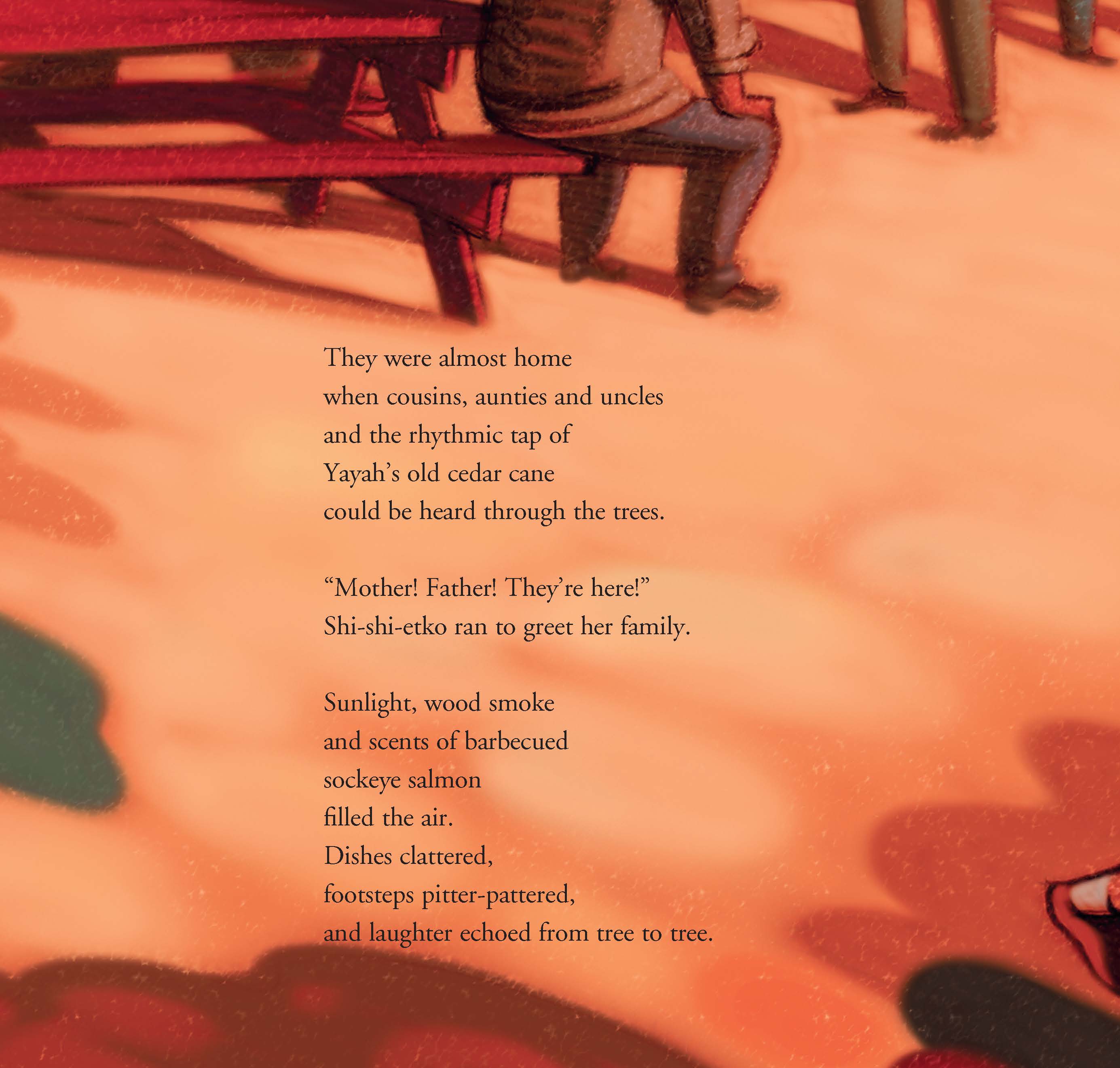

Page 7 & 8
They were almost home when cousins, aunties and uncles and the rhythmic tap of Yayah’s old cedar cane could be heard through the trees.
“Mother! Father! They’re here!” Shi-shi-etko ran to greet her family.
Sunlight, wood smoke and scents of barbecued sockeye salmon filled the air. Dishes clattered, footsteps pitter-pattered, and laughter echoed from tree to tree.

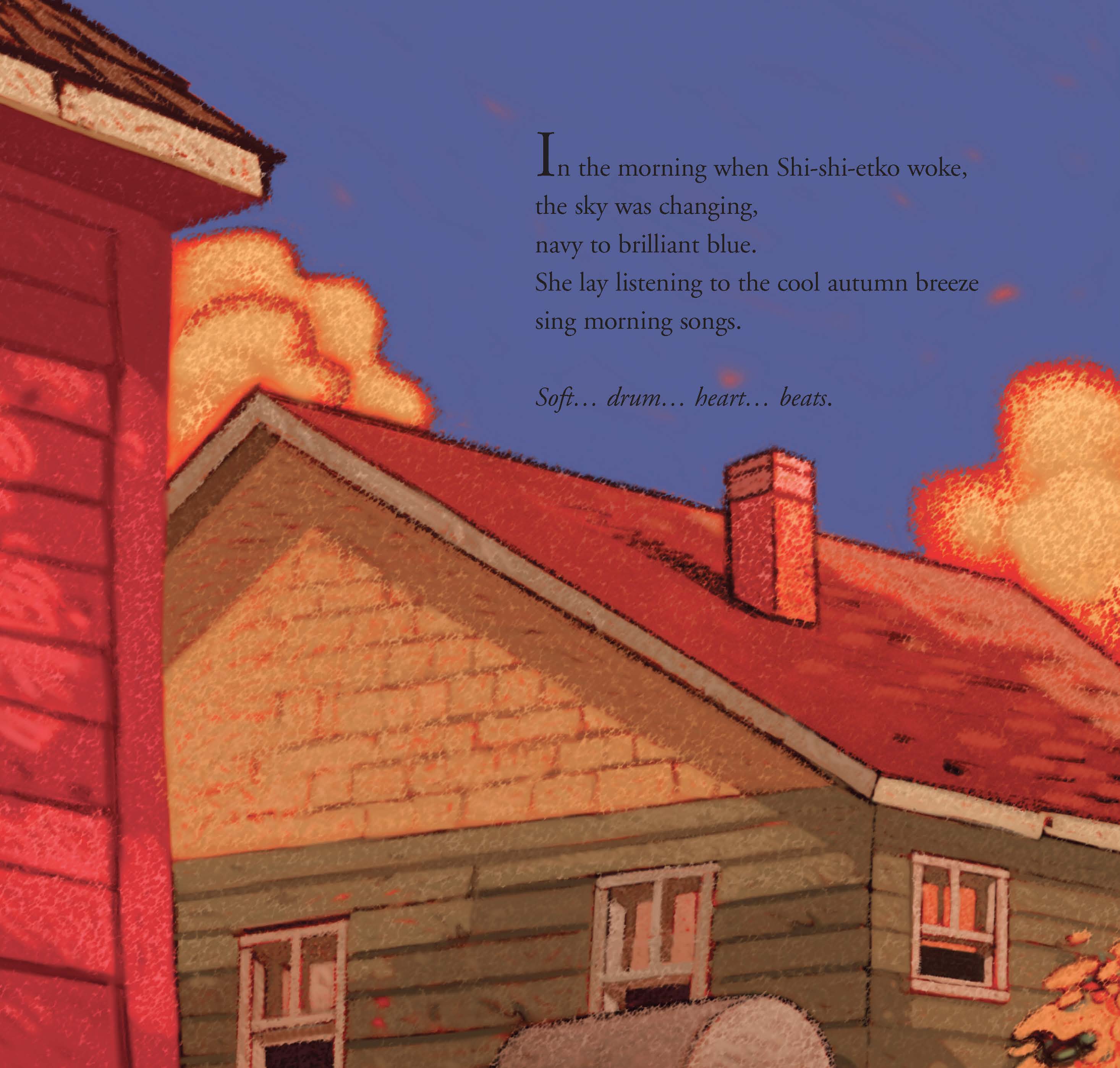
Page 9 & 10
Afterwards in the late-night silence, tucked safely under Yayah’s patchwork quilt, Shi-shi-etko counted her fingers. “There are only one, two, three more sleeps until I go to school.”
In the morning, when Shi-shi-etko woke, the sky was changing, navy to brilliant blue. She lay listening to the cool autumn breeze sing morning songs.
Soft…drum…heart…brass.


Page 11 & 12
“Let’s take the canoe out on the lake,” said her father. Hand in hand they walked along the creek all the way to the lake.
“My girl, these are the things you must always remember,” he said, gesturing to the trees, mountains and water around them.
Together they picked up the canoe and carried it to the water’s edge.
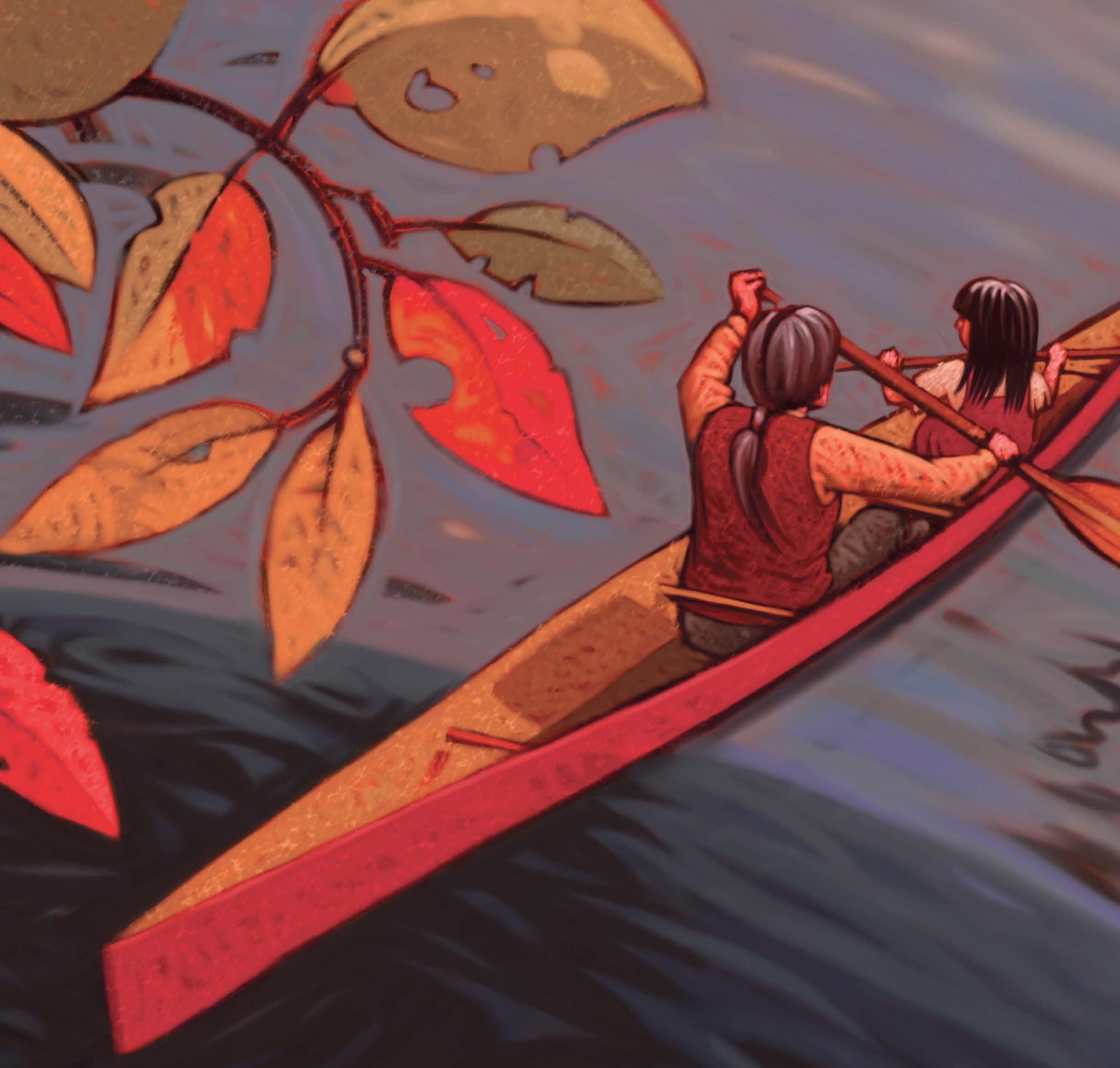

Page 13 & 14
With yellow cedar puddles, they strolled across smooth water.
Reach, dip, pull back…
Reach, dip, pull back…
The only sounds they heard were the whistling birds and their paddles breaking the surface of the lake, surrounding the with ripples.
Circle on…circle on…circle…
Her father sand the paddle song that her grandfather used to sing. His voice traveled across the water, a chant that kept their pace.

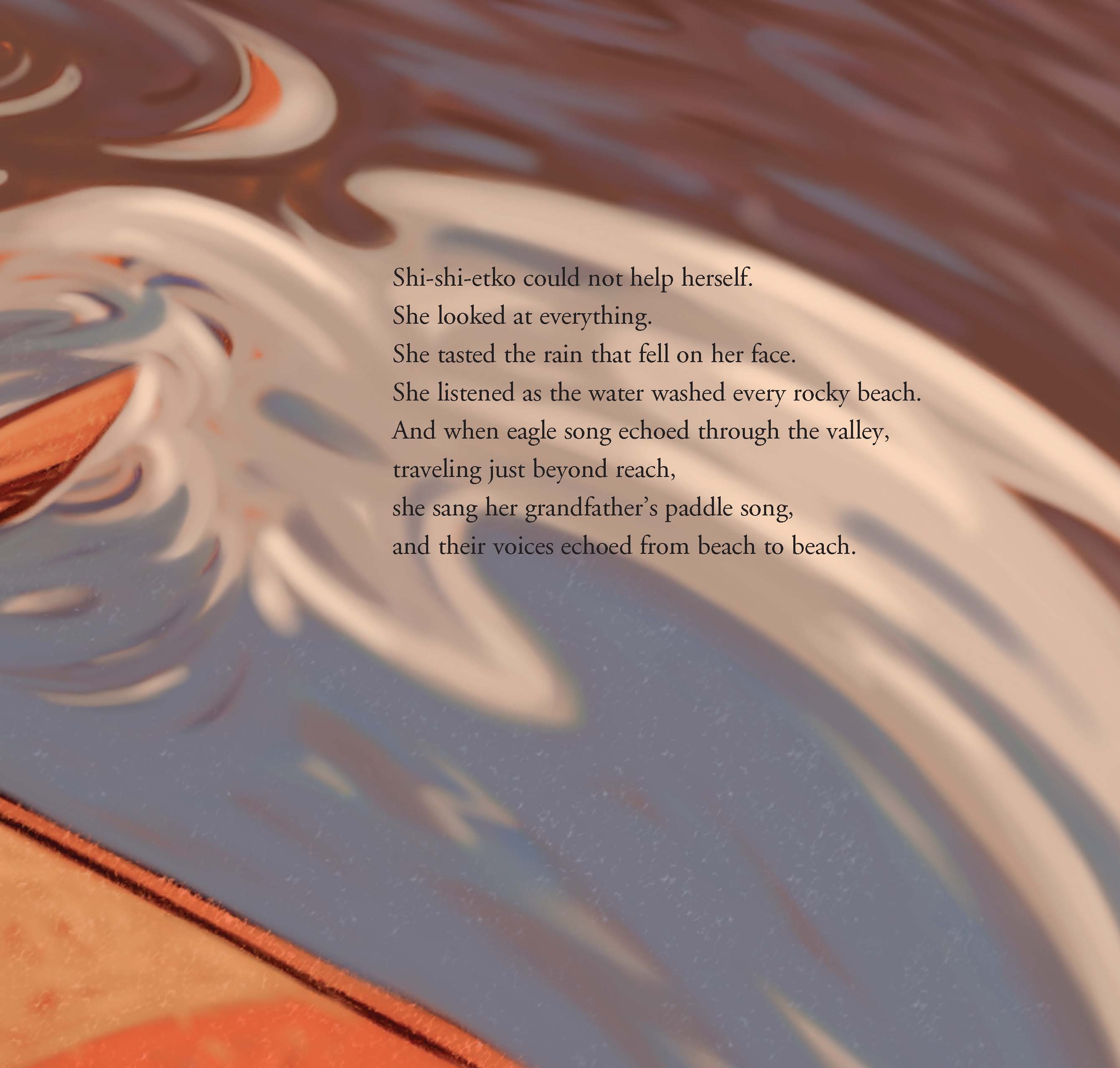
Page 15 & 16
Shi-shi-etko could not help herself. She looked at everything. She tasted the rain that fell on her face. She listened as the water washed every rocky beach. And when eagle song echoed through the valley, traveling just beyond reach, she sang her grandfather’s paddle song, and their voices echoed from beach to beach.
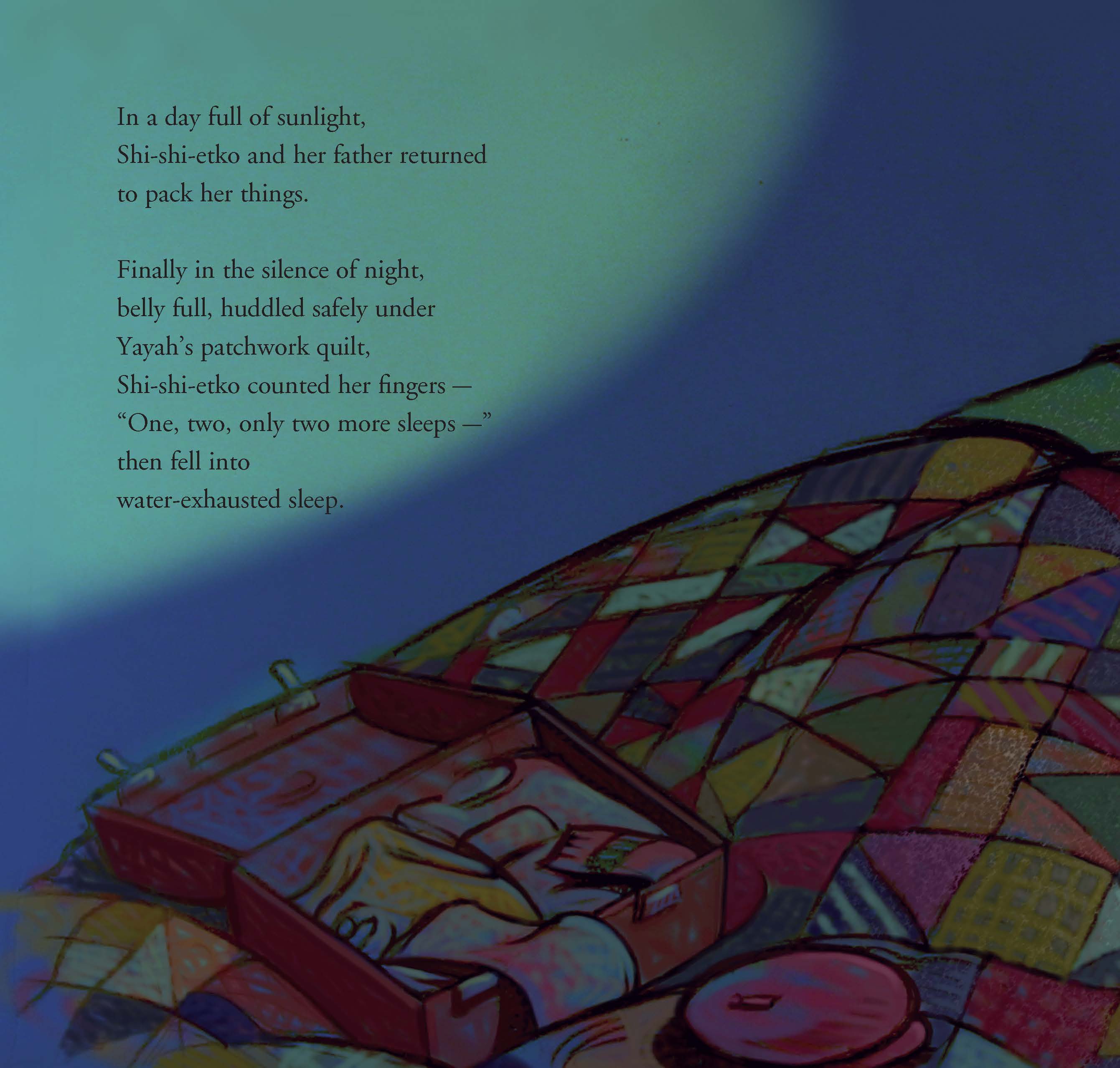
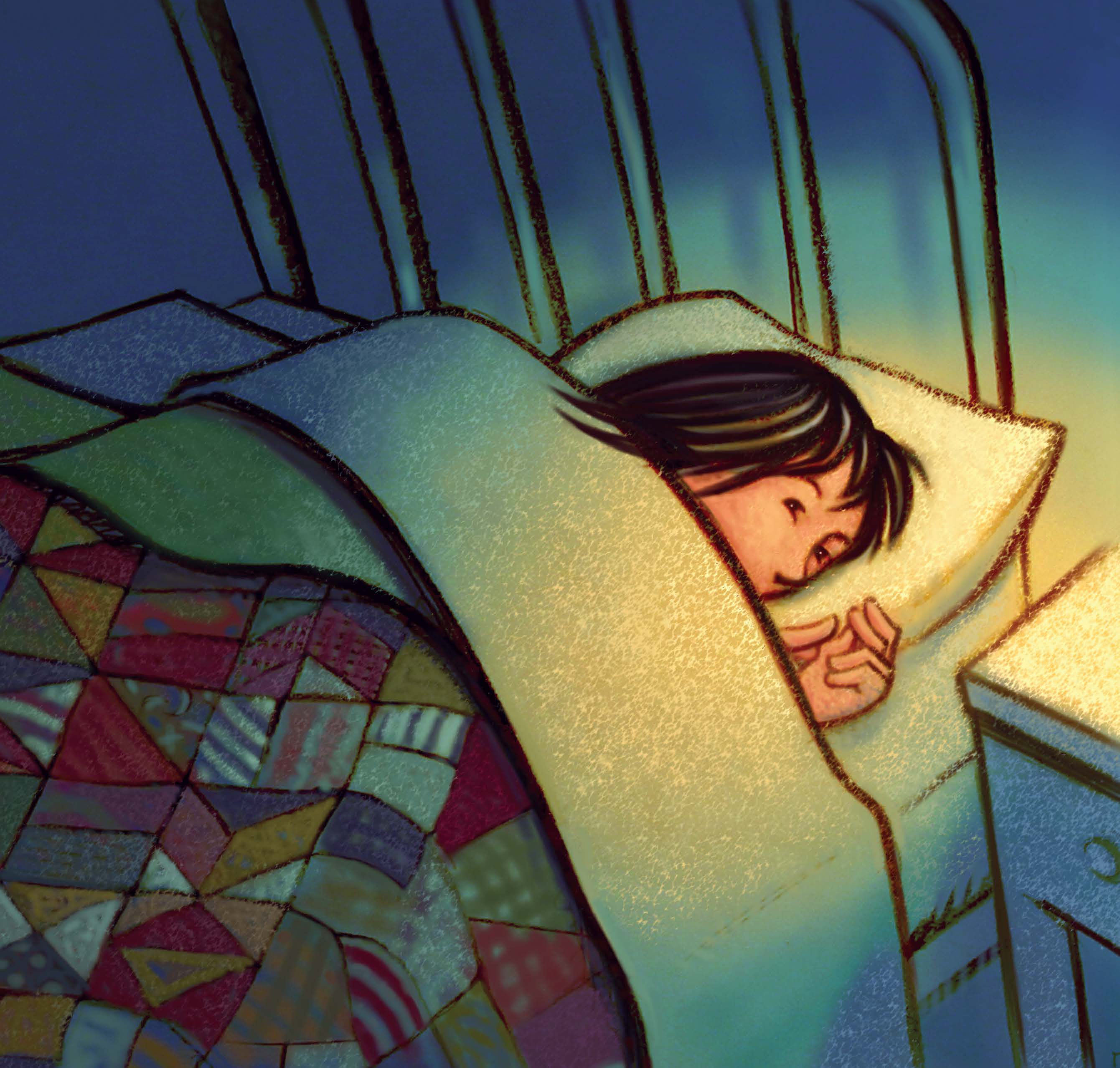
Page 17 & 18
In a day full of sunlight, Shi-shi-etko and her father returned to pack her things.
Finally in the silence of night, belly full, huddled safely under Yayah’s patchwork quilt, Shi-shi-etko counted her fingers— “One, two, only two more sleeps—” then fell into water exhausted sleep.
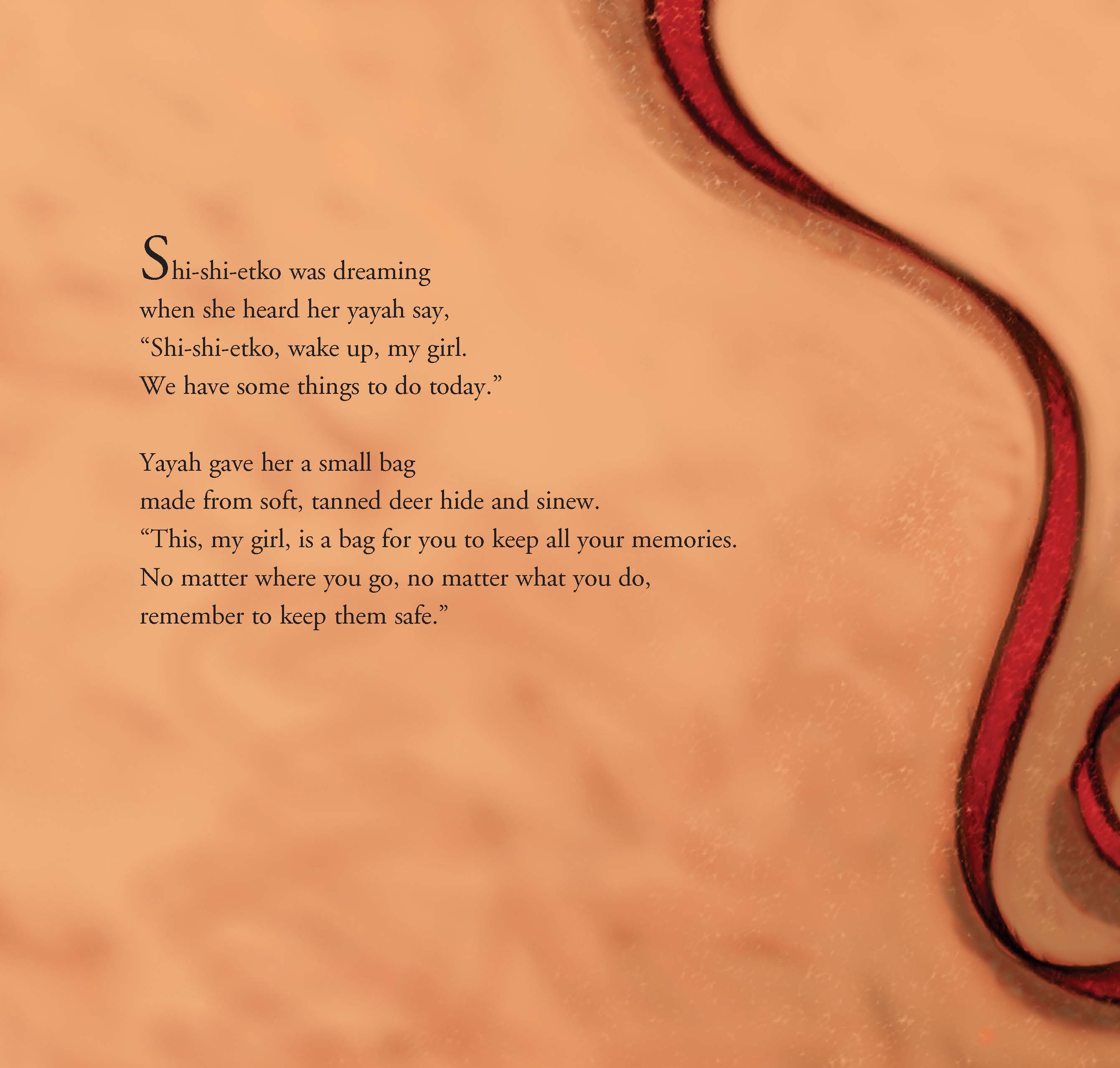
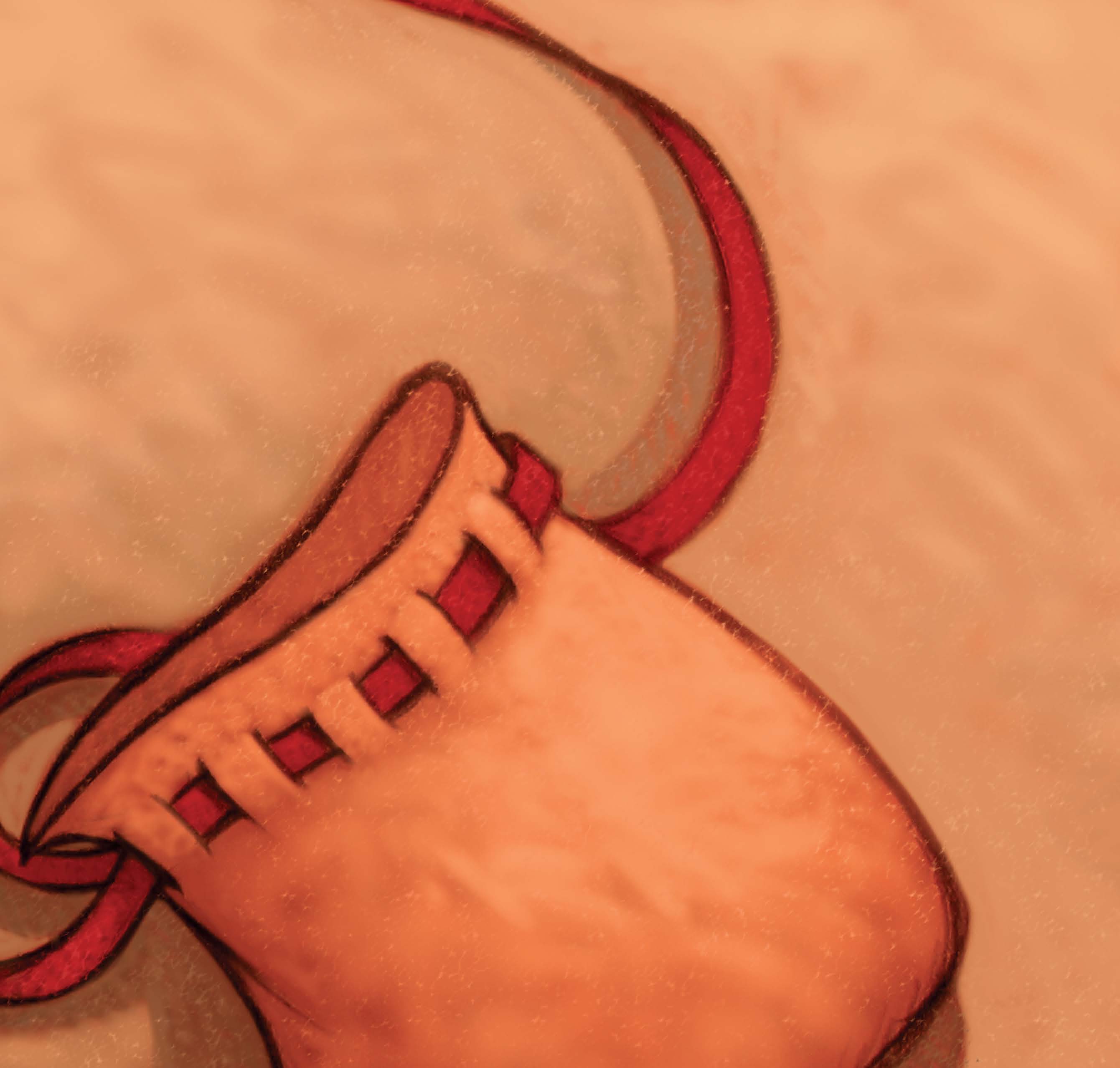
Page 19 & 20
Shi-shi-etko was dreaming when she hear her Yayah say, “Shi-shi-etko, wake up, my girl. We have some things to do today.”
Yayah gave her a small bag made from soft, tanned deer hide and sinew.
“This, my girl, is a bag for you to keep all your memories. No matter where you go, no matter what you do, remember to keep them safe.”

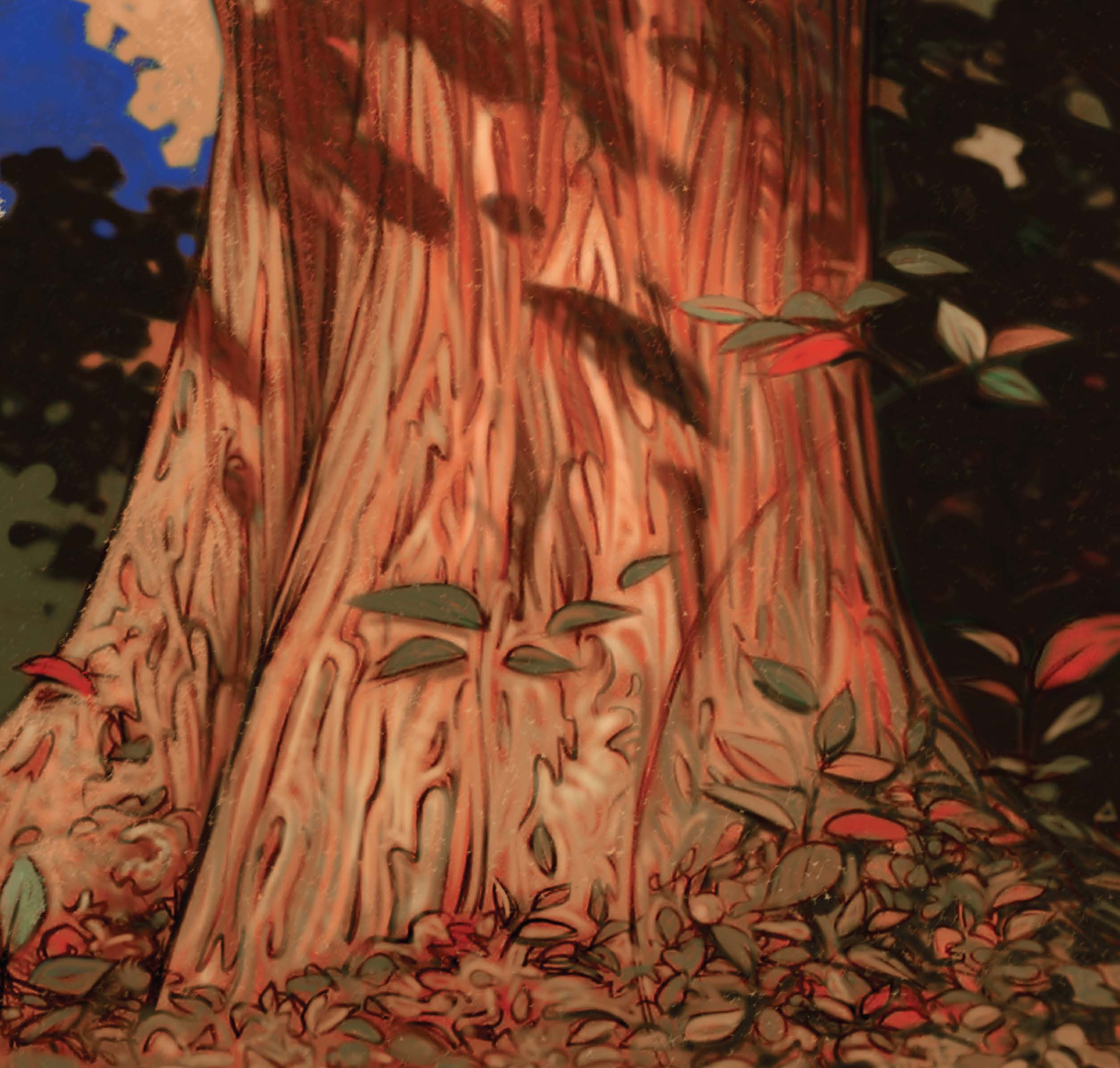
Page 21 & 22
The sun wasn’t up yet when they walked out the door and into the trees. The path was dark and smelled alive with rain, wet soil and leaves. They walked until the stun was shining.
Yayah brought her to visit a great big fir tree. Shi-shi-etko placed a sprig into her bag of memories. They visited a hemlock, a cedar, even a pine, and each time she placed a sprig into her bag of memories.
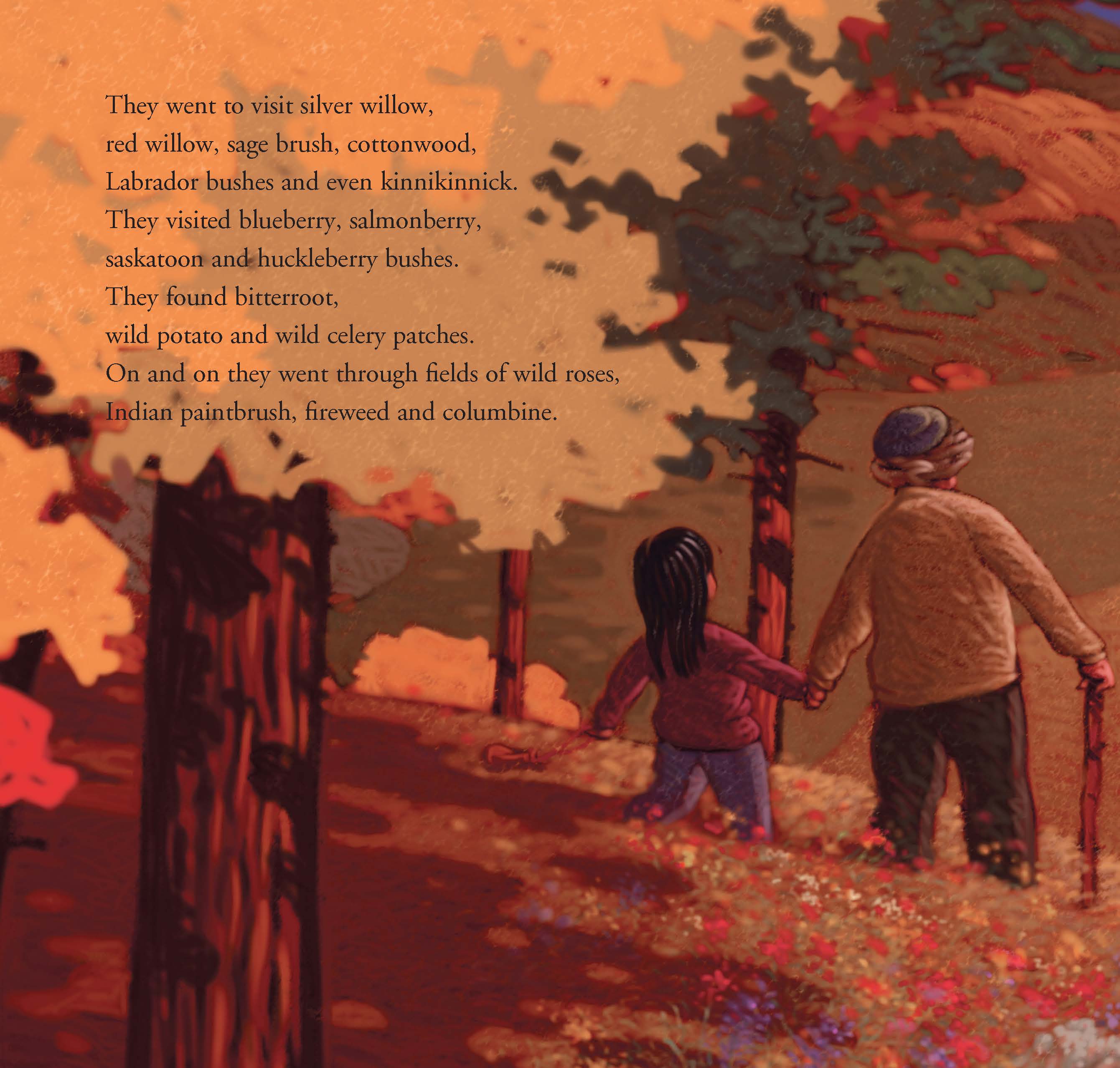
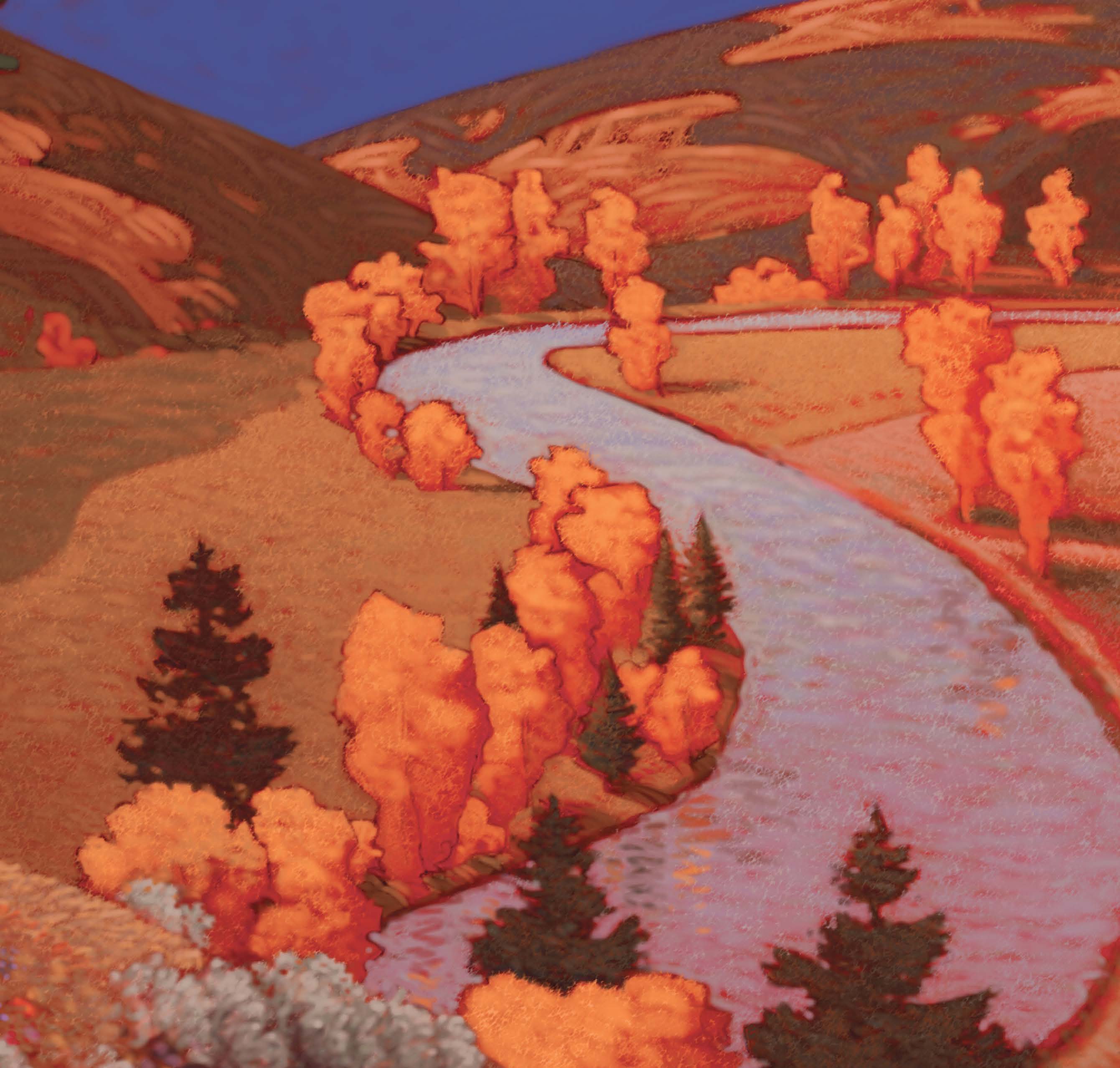
Page 23 & 24
They went to visit silver willow, red willow, sage brush, cottonwood, Labrador bushes and even kinnikinnick. They visited blueberry, salmonberry, saskatoon and huckleberry bushes. They found bitterroot, wild potato and wild celery patches. On and on they wen through fields of wild roses, Indian paintbrush, fireweed and columbine.

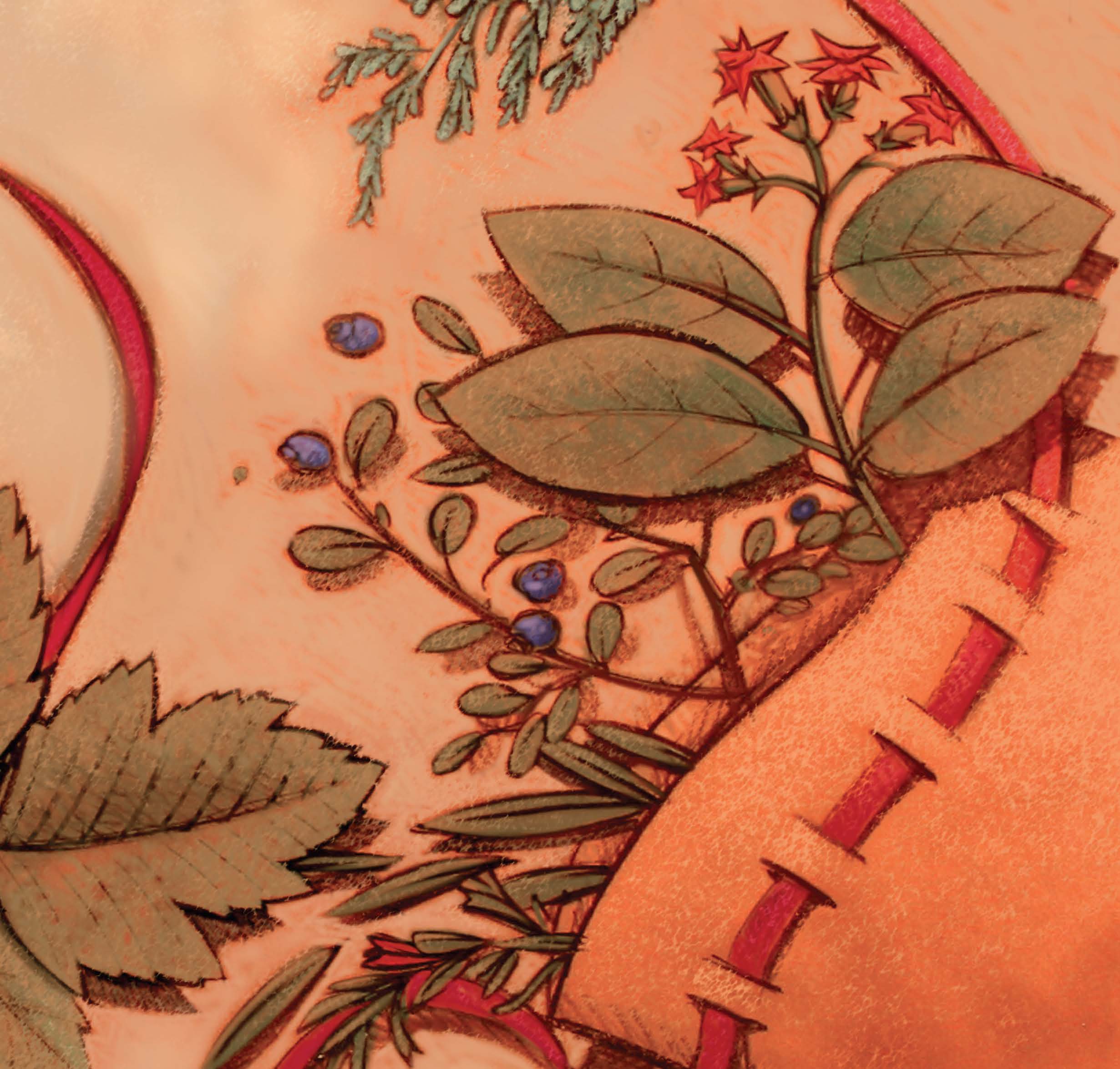
Page 25 & 26
Shi-shi-etko promised herself, “I will remember everything.”
Each plant they came to, she listened carefully to its name.
Then asked once, twice, even three times, “Is it food or medicine, Yayah? Is it always safe?”
Then, whispering its name, she placed dried berry, root, flower and fragrant leaf into her bag of memories.
That night when Shi-shi-etko crawled under her patchwork quilt, she counted her fingers and said, “One, only one more sleep.”
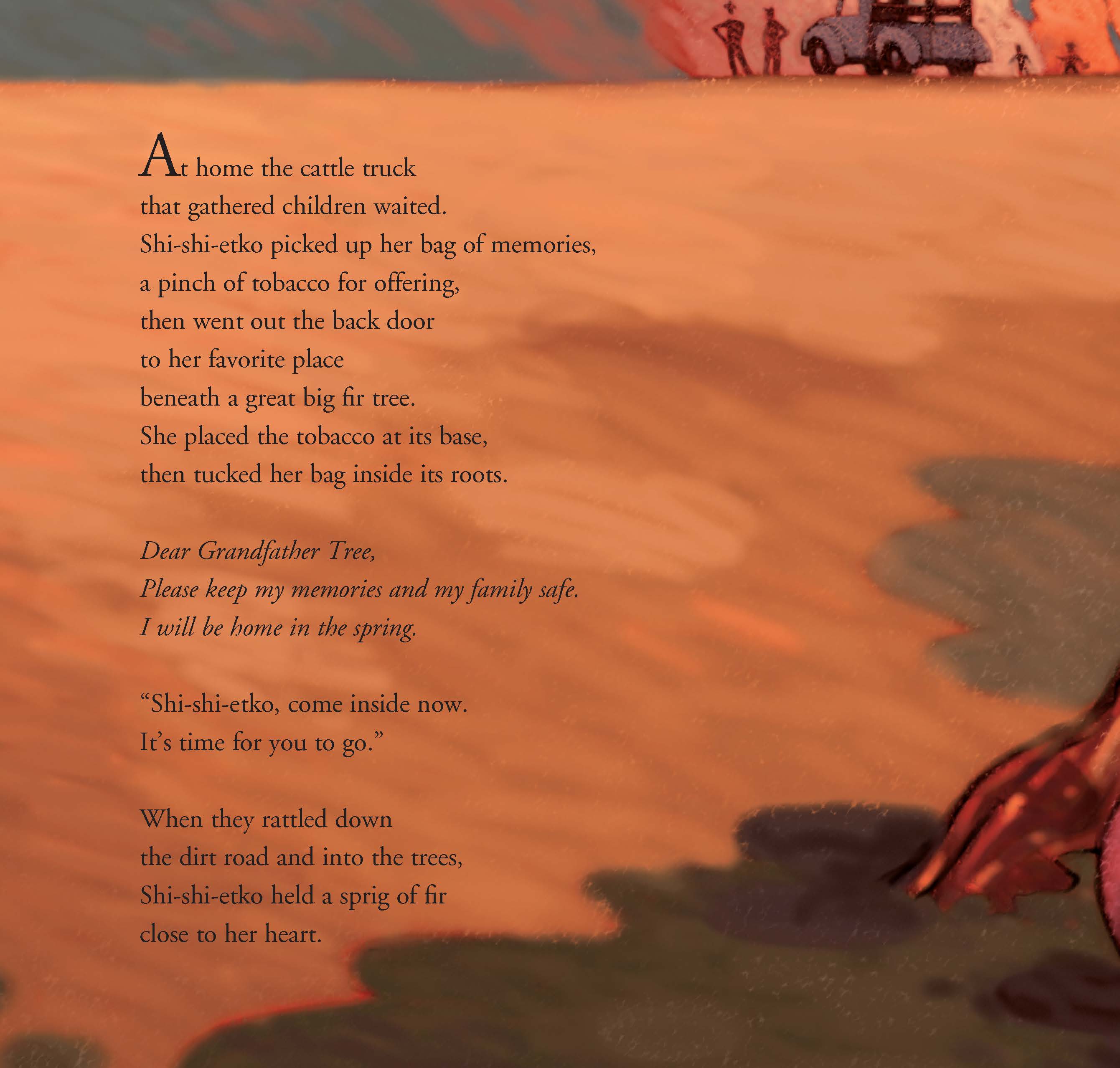
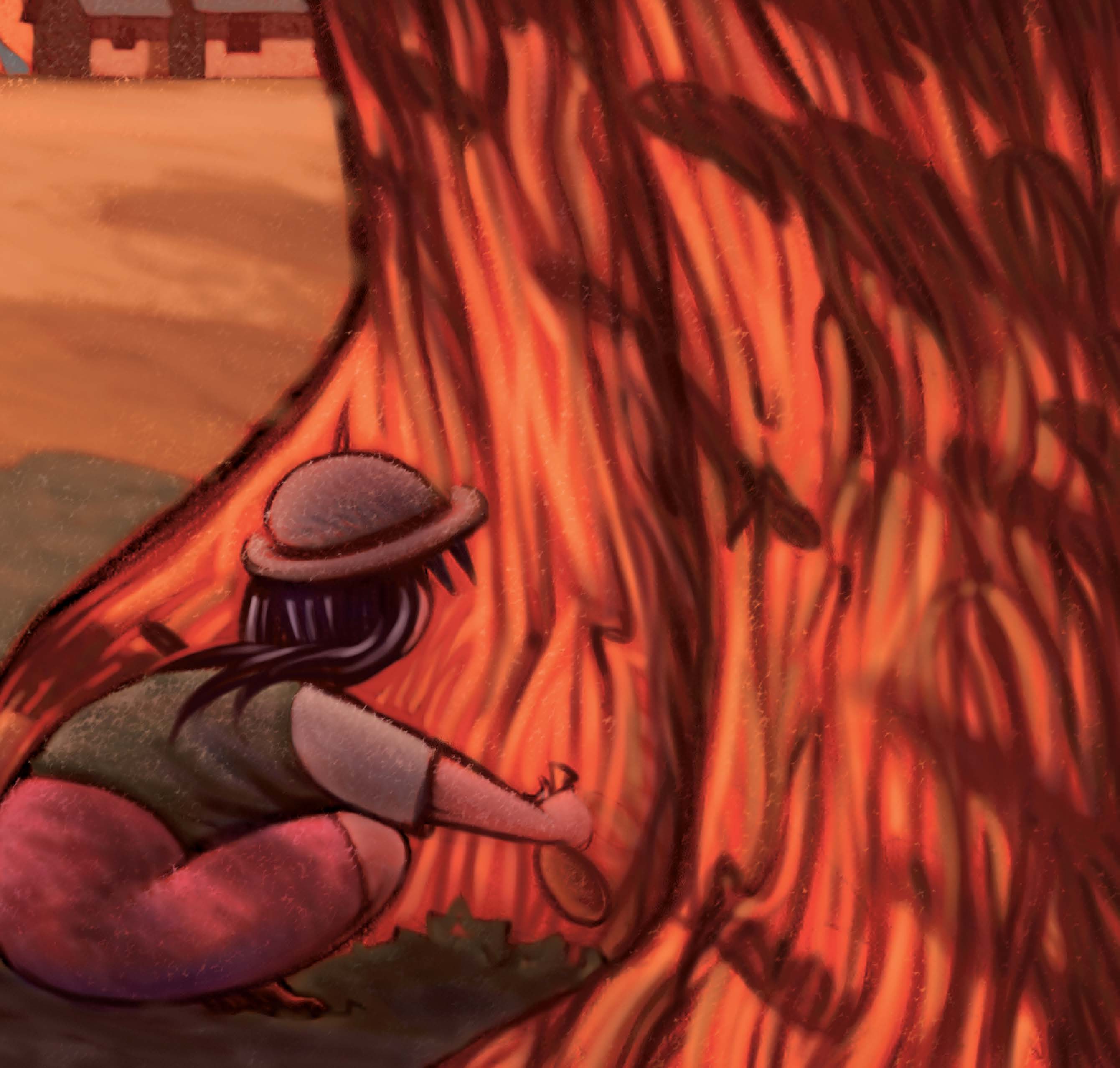
Page 27 & 28
At home the cattle truck that gathered children waited. Shi-shi-etko picked up her bag of memories, a pinch of tobacco for offering, then went out the back door to her favourite place beneath a great big fir tree. She placed the tobacco at its base, then tucked her bag inside its roots.
Dear Grandfather Tree,
Please keep my memories and my family safe. I will be home in the spring.
“Shi-shi-etko, come inside now. It’s time for you to go.” When they rattled down the dirt road and into the trees, Shi-shi-etko held a sprig of fir close to her heart.
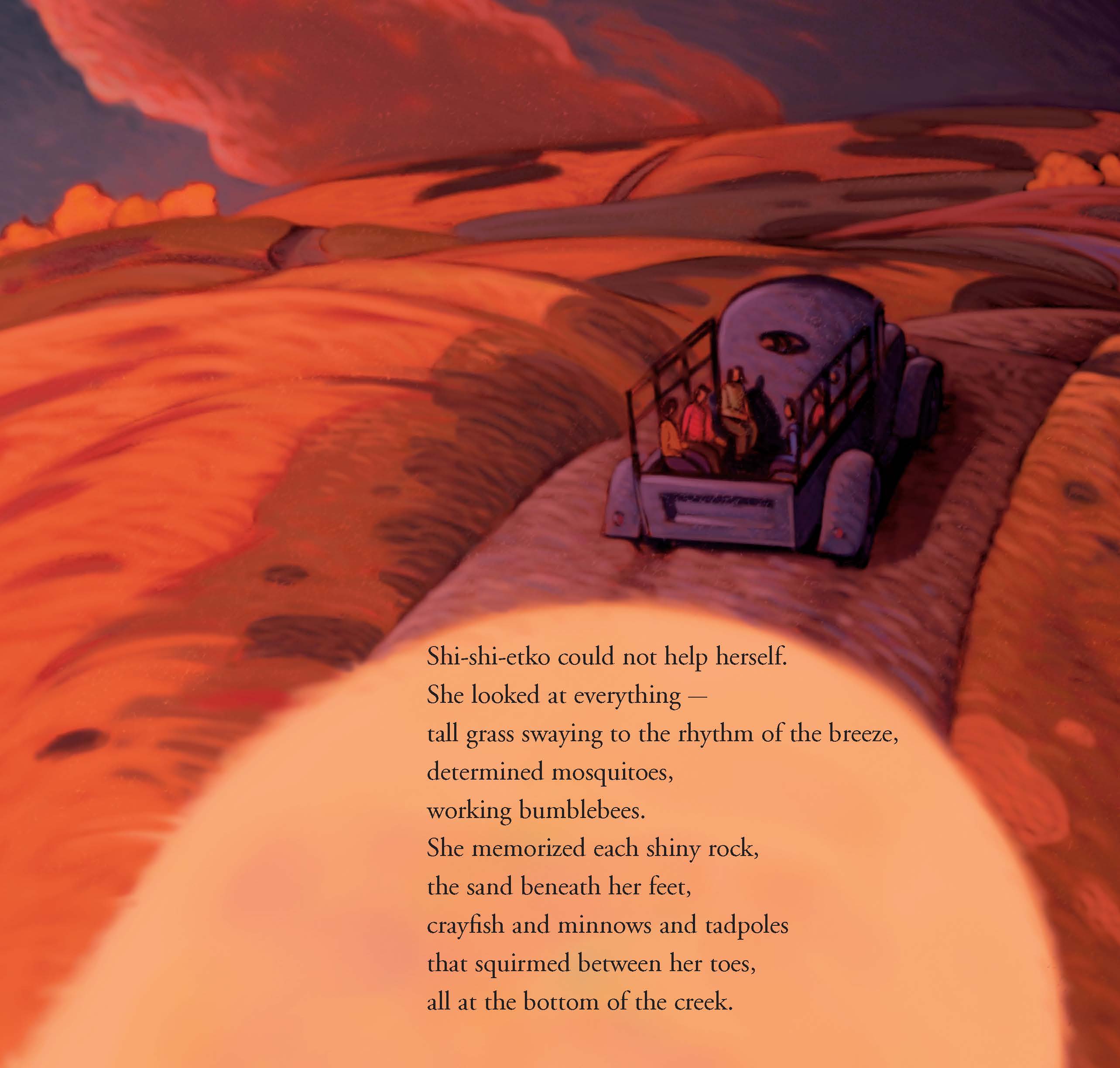
Page 29
Shi-shi-etko and the other children are seated in the back of a low, dark purple cattle truck. The truck is heading on dark coloured road that is winding over many hills. The sky is dark blue, and the sun is setting in the evening, with warm orange tinges over the land and hills. However, over the truck, there is the shadow of a cloud resulting in a brownish orange over the children and the truck.
Text: Shi-shi-etko could not help herself. She looked at everything— tall grass swaying to the rhythm of the breeze, determined mosquitoes, working bumblebees.
She memorized each shy rock, the sand beneath her feet, crayfish and minnows and tadpoles that squirmed between her toes, all at the bottom of the creek.
Learning check!
Respond to the following questions after exploring Shi-shi-etko:
How many times does Shi-shi-etko return to the river throughout the story?
What does the character do each time she returns?
When you’re ready, press ‘Let’s Check!’ to access the correct answer.
Shi-shi-etko returns to the river 3 times throughout the story
Shi-shi-etko visits the river with her mother, then her father, and while walking along the riverside with her Yayah.
What kinds of memories does Shi-shi-etko create with her mother? Her father? Her grandmother?
When you’re ready, press ‘Let’s Check!’ to access a possible response.
Throughout the story, Shi-shi-etko comes back to the river.
She bathes in the river with her mother, canoes through the river with her father, and walks past the river with her Yayah.
Each time she interacts with the river or with water, she creates powerful memories. Her family shares with her their traditions and ways of knowing, and this includes a powerful connection with the land and water.
The role of water in the story provides the reader with an understanding of these different characters.
How does Shi-shi-etko’s relationship with water help us to better understand them?
What do you think this reflects about Indigenous perspectives on the lands and waters?
When you’re ready, press ‘Let’s Check!’ to access a possible response.
Shi-Shi-etko and her family spend a lot of time on the land and by the water making memories.
I think this demonstrates how the Indigenous peoples care for the land and water, as part of their worldviews and values.
Land and water
Explore this video entitled ”Relationships to Land and Water” to learn more about the importance of the land and water.
Learning check!
After exploring the video, reflect on the following statements.
Select the correct answer, then press ‘Check Answer’ to see how you did.
Pause and Reflect
Pause and reflect
Let’s pause and reflect on the following questions:
- Why is it important to keep the land and waters in pristine condition?
- How does the land and waters of Kitchenuhmaykoosib Inninuwug compare to where you live?
- Is it possible to drink water from the lake where you live? If not, why?
- What has caused the water from the lake where you live to become polluted?
Record your ideas in a notebook or another method of your choice.
Share your ideas with a partner, if possible.

Brainstorm
Advocating for water
Autumn Peltier is an Anishinaabe youth from Wiikwemkoong First Nation.
Access the following video to learn more about Autumn’s advocacy to protect water.
After exploring the video, respond to the following questions:
- Why is water important to Autumn Peltier?
- What is the role of water in her life?
- What is the common idea you have learned from exploring Shi-shi-etko, the Kitchenuhmaykoosib Inninuwug First Nation, and the work of Autumn Peltier?
Then, brainstorm a list of words that share what you have learned from each source.
Record your ideas in a notebook or another method of your choice.
The role of water
Shi-shi-etko, she who loves to play in water, keeps returning to the river because the role of water is deeply connected to her culture and community. This is represented in the voices of the people of the Kitchenuhmaykoosib Inninuwug First Nations and in the voice of Autumn Peltier.
Water is the setting in and outside the story of Shi-shi-etko.
What is the role of water in your own life?
Record your ideas in a notebook or another method of your choice.
Consolidation
News reporting

Imagine you are a reporter giving a news report on what you have learned from the Kitchenuhmaykoosib Inninuwug First Nation community and the water protection advocate, Autumn Peltier.
Press the following tabs to access the parts of a news report.
A headline is the title of a news report. It is meant to catch the audience’s attention.
For example, “What is the role of water in your life?”
An introduction tells the reader what the report is about. Introductions can be 1-2 sentences.
What is the news report about? Who are your sources?
The body of the report is where the reader can explore the important facts and information that support the headline and introduction. The body of a news report is around 3-4 sentences.
What kind of information will you share with your audience?
Hint: You may use your brainstorming list from the Action section to inform the body paragraph.
A conclusion is a quick summary of the report, but also leaves the reader with something to remember.
What would you like the reader to remember from your news report?
You may use the following checklist to guide your news report.
News report
Do I have a…?
Complete the News Report Organizer in your notebook or using the following fillable and printable document. If you would like, you can use speech-to-text or audio recording tools to record your thoughts. Consider adding your work to your drama portfolio.
|
Headline |
|
|
Introduction |
|
|
Body |
|
|
Conclusion |
Press the ‘Activity’ button to access News Report Organizer.
Practise your news report. How could you use your body, face, and/or voice to present your news report?
If possible, present your news report to a partner, or create a recording.
Consider adding your work to your drama portfolio.
Portfolio
Review your learning
Let’s reflect on the following questions:
How do time and place help an audience understand the characters in a drama story?
Consider what kind of connections you have made between the story Shi-shi-etko, the voices of the people of the Kitchenuhmaykoosib Inninuwug First Nations and the voice of Autumn Peltier.
Reflect once more on your own connection to water. Has it changed since the beginning of this learning activity? Why or why not?
Record your ideas in a notebook or another method of your choice.
Consider adding your work to your drama portfolio.
Reflection
As you read through these descriptions, which sentence best describes how you are feeling about your understanding of this learning activity? Press the button that is beside this sentence.
I feel…
Now, record your ideas using a voice recorder, speech-to-text, or writing tool.
Discover MoreWe all need to remember that the protection of clean water is an important issue for everyone.
Research a water issue that affects your local community. Be sure to search safely and use trusted sources.
Based on the information you find, create a video or a post that raises awareness about the issue. Consider adding your work to your drama portfolio.
Questions to consider:
- What can individuals in the community do to help?
- How could different organizations get involved?
- How might the community communicate this issue to the municipal government (local government offices)?
